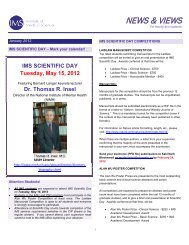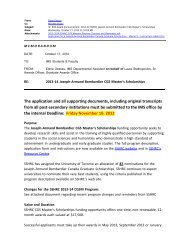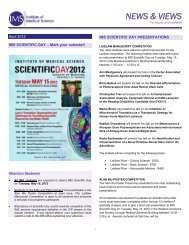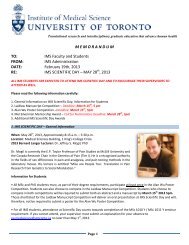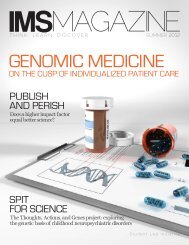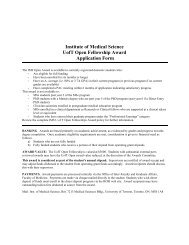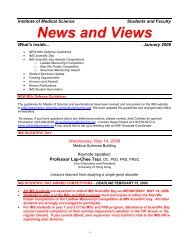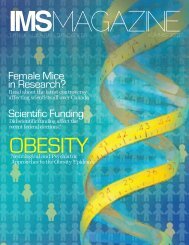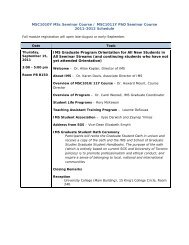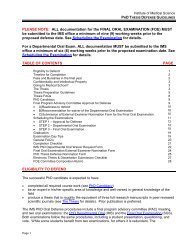Fall 2011 - Institute of Medical Science - University of Toronto
Fall 2011 - Institute of Medical Science - University of Toronto
Fall 2011 - Institute of Medical Science - University of Toronto
You also want an ePaper? Increase the reach of your titles
YUMPU automatically turns print PDFs into web optimized ePapers that Google loves.
COMMENTARY<br />
Tell us what you think<br />
“Just a quick email to congratulate [your<br />
team] on the IMS Magazine. Very interesting<br />
content and nice to get a flavour <strong>of</strong><br />
what else is happening at IMS.”<br />
– Colin McCartney, Associate IMS Member<br />
“Congratulations! The magazine looks brilliant.”<br />
– Santhosh, IMS student<br />
“[The magazine] looks great and the content<br />
is interesting and well put together…<br />
Looking forward to future issues.”<br />
– Wilfred Ip, IMS student<br />
“The magazine looks fantastic and reads<br />
extremely well with an excellent balance <strong>of</strong><br />
interesting articles about students, faculty,<br />
staff and the life as an IMS student. ”<br />
– Dr. Karen Davis, IMS Associate Director<br />
What to look for next issue:<br />
The Surgical Management <strong>of</strong> Obesity by<br />
Dr. Teodor Grantcharov<br />
Commentary<br />
Dear Editor:<br />
I read the most recent (Summer <strong>2011</strong>) edition<br />
<strong>of</strong> the IMS Magazine with great interest<br />
and enjoyed its focus on obesity/BMI. The<br />
magazine only briefly mentioned that BMI<br />
varies across ethnic groups. I would like to<br />
elaborate more on these ethnic variations using<br />
empirical evidence from my IMS PhD<br />
thesis findings.<br />
Many agree that the definition <strong>of</strong> obesity<br />
(BMI≥30) is inappropriate in non-white<br />
populations and that lower cut<strong>of</strong>f values are<br />
required for Asian populations, however no<br />
previous study has been able to pinpoint exactly<br />
what the BMI cut<strong>of</strong>f values should be<br />
for specific Asian ethnic groups. I therefore<br />
conducted a multiethnic cohort study <strong>of</strong> approximately<br />
60,000 non-diabetic adults aged<br />
30 years or over living in Ontario. Subjects<br />
were identified from Statistics Canada’s population<br />
health surveys and were followed for<br />
up to 12.8 years for diabetes incidence using<br />
record linkages to multiple health administrative<br />
databases.<br />
The study found that for the equivalent incidence<br />
rate <strong>of</strong> diabetes at BMI 30 in the<br />
White group, the BMI cut<strong>of</strong>f value was 24<br />
in the South Asian group, 25 in the Chinese<br />
group, and 26 in the Black group. Moreover,<br />
the risk <strong>of</strong> diabetes was significantly higher<br />
among the South Asian (hazard ratio (HR):<br />
3.40, p



